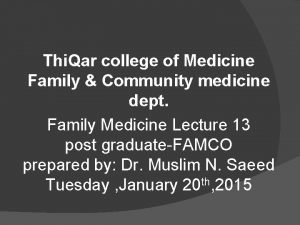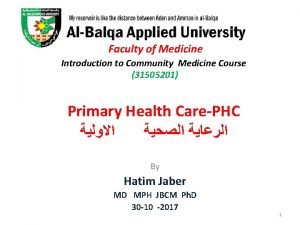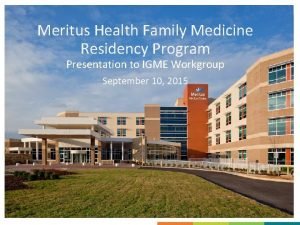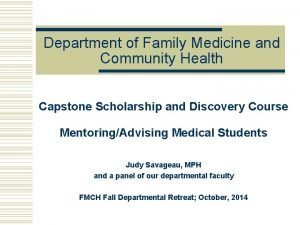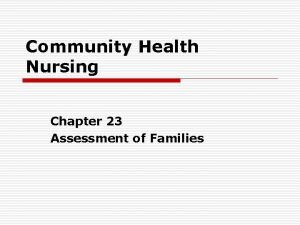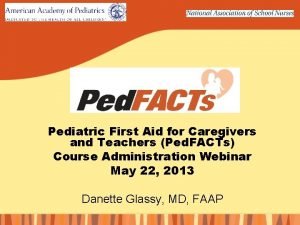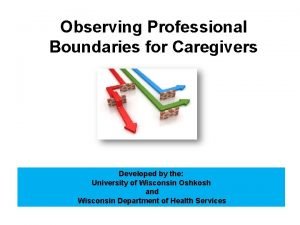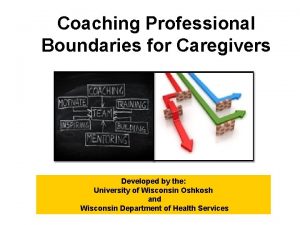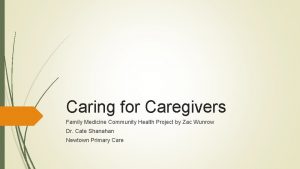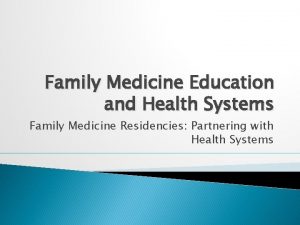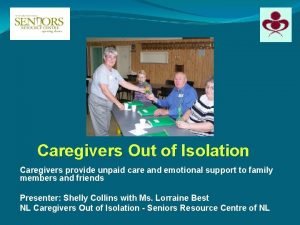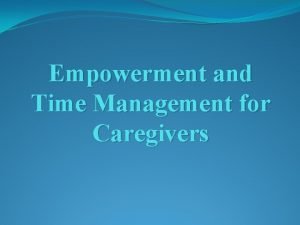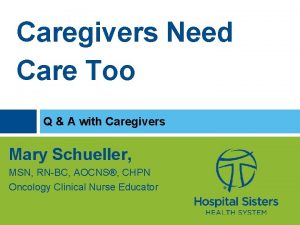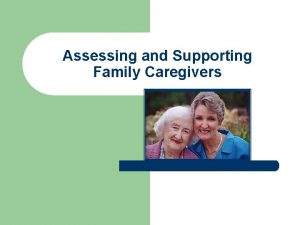Caring for Caregivers Family Medicine Community Health Project










- Slides: 10

Caring for Caregivers Family Medicine Community Health Project by Zac Wunrow Dr. Cate Shanahan Newtown Primary Care

Role of Caregivers in Healthcare In 2015, 34. 2 million Americans provided unpaid care to an adult age 50 or older 80% of adults requiring long-term care for a chronic illness or disability live at home; unpaid family caregivers provide 90% of their care Demand for family caregivers only expected to increase, due to an aging population, increased number of individuals living with chronic disease, shorter hospital stays, changes in insurance reimbursement, and proliferation of in-home care technology and services >50% of caregivers help with at least one ADL, and at least four IADLs Average caregiver: 49 year old woman 20. 5 hrs/week; 20% >40 hours/week One-third have provided care for >5 years

Caregiver Burden No ICD-10 code Zarit definition: “the extent to which caregivers perceive that caregiving has had an adverse effect on their emotional, social, financial, physical, and spiritual functioning. ” One-third of caregivers report a “high” burden of care These caregivers are more likely to live with the care recipient, be in poorer health, have financial stress, and perceive they had no choice in accepting the role A majority of caregivers describe having less time for family and friends, having increased emotional stress, and neglecting self-care, including exercise, dietary habits, and adequate sleep 72% of caregivers report “not going to the doctor as often as I should” since they began providing care 5 x risk of experiencing participation restrictions in valued activities; 3 x risk of experiencing decreased work productivity

A Caregiver’s Health Risks Combination of prolonged stress, the physical demands of caregiving, loss, and biological vulnerabilities of older caregivers compromises physiological functioning and increases their risk for physical health problems, leading to increased mortality Schulz et al. (1999): “independent risk factor for mortality, ” 63% increased four-year mortality Half of all caregivers have at least one chronic condition Higher rates of insomnia and depression Less likely to engage in preventative health measures Half of caregivers reporting decline in their own health state that their ability to provide care is consequently compromised “[Caregiver depression] is driven not only by the work of care, but also by the fact that you are in daily contact with someone who is depressed, disabled, and feeling they are a burden to others. It is that exposure to the suffering of somebody close to you that contributes to your own suffering. ” -- Dr. Richard Schulz, Psychiatry Professor at University of Pittsburgh

Caregiver Perspective 25% of caregivers utilize supportive services, and 77% report needing more information about support services Caregivers stated that they would be most likely to use the internet (29%) or their doctors (28%) as primary sources for information related to caregiving 81% of caregivers feel inadequately trained for the skills that they perform, not having received formal education in caregiving ~50% report responsibility for complex medical tasks, including wound care, treating pressure ulcers, administering parenteral medications, and maintaining feeding tubes Although caregivers regularly interface with the health care system, they frequently receive inadequate support from health providers and feel unrecognized by the health care system

Screening for Caregiver Burden PCPs are uniquely positioned to identify caregiver burden and aid caregivers in achieving adequate support When presented with apparent caregiver burden, PCPs can gauge caregiver perception of their own well-being, perceived challenges and benefits of caregiving, confidence in their abilities, and the need for additional support systems

How Can PCPs Help Relieve Caregiver Burden? When a patient resists the idea of accepting home health care services, a physician's strong recommendation may be more likely to be considered and ultimately adopted Discuss advance care planning and determine if referrals are necessary End-of-life discussions, particularly those that occur before the last month of life, are associated with improvements in quality of life, receipt of desired care, reduced physical suffering, improved family coping, and increased use of hospice Physicians have a responsibility to raise these issues with patients as the disease begins to worsen Possible suggestions and referrals: home care, rehabilitative services (speech, PT/OT), mental health services, spiritual services, caregiver support groups, nutritional services, community volunteer services, medical devices (including automatic medication dispensers, mobility monitors, scooters and lifting systems), food delivery, and palliative care In a study of individuals utilizing palliative care, access to professional support was demonstrated to improve quality of life for patients and caregivers, lower the burden of home care for the caregiver, improve symptom management, and decrease unnecessary hospital/ER utilization

Treating the Patient-Caregiver Dyad Schulz suggests that when patients and caregivers are treated as a dyad, outcomes for both are improved Older married couples might be evaluated together, exploring their health status and openly discussing caregiving demands at home Treatment should account for the needs of patient and caregiver Additionally, physicians should ideally evaluate patient and caregiver separately to allow for communication of confidential information such as caregiver stress and elder mistreatment Scheduling consecutive visits on the same day

Caregiver as Member of Care Team Healthcare providers may aim to more purposefully engage and support caregivers as active partners in care Be cognizant of caregiver burden and intervene in a timely manner to help alleviate this burden Caregivers may be thought of as members of patient’s interdisciplinary care team (PCMH model) Gillick: “guided care” program offers comprehensive care to patients with chronic illnesses, utilizing NPs to perform home-based geriatric assessments and educate caregivers Decreased costs and increased patient satisfaction compared with conventional care

References Adelman, R. D. , Tmanova, L. L. , Delgado, D. , Dion, S. , & Lachs, M. S. (2014). Caregiver burden: a clinical review. JAMA, 311(10), 1052 -1060. Aldrich, N. (2011). CDC seeks to protect health of family caregivers. National Association of Chronic Disease Directors. Collins, L. G. , & Swartz, K. (2011). Caregiver care. American family physician, 83(11), 1309. Family Caregiver Alliance (2012). Fact sheet: Selected caregiver statistics. San Francisco, CA. Gillick, M. R. (2013). The critical role of caregivers in achieving patient-centered care. Jama, 310(6), 575 -576. Graessel, E. , Berth, H. , Lichte, T. , & Grau, H. (2014). Subjective caregiver burden: validity of the 10 -item short version of the Burden Scale for Family Caregivers BSFC-s. BMC geriatrics, 14(1), 23. Schulz, R. , O'Brien, A. , Czaja, S. , Ory, M. , Norris, R. , Martire, L. M. , . . . & Burns, R. (2002). Dementia caregiver intervention research: in search of clinical significance. The Gerontologist, 42(5), 589 -602. Schulz, R. , & Beach, S. R. (1999). Caregiving as a risk factor for mortality: the Caregiver Health Effects Study. JAMA, 282(23), 2215 -2219. Wolff, J. L. , Spillman, B. C. , Freedman, V. A. , & Kasper, J. D. (2016). A national profile of family and unpaid caregivers who assist older adults with health care activities. JAMA internal medicine, 176(3), 372 -379.
 Caring occasion/caring moment
Caring occasion/caring moment Duke family medicine and community health
Duke family medicine and community health Types of family in community medicine
Types of family in community medicine Elements of primary health care
Elements of primary health care Meritus family practice
Meritus family practice Sharing is caring ne demek
Sharing is caring ne demek Family and community health advisor
Family and community health advisor Family care plan in community health nursing
Family care plan in community health nursing First aid for caregivers
First aid for caregivers Zone of helpfulness
Zone of helpfulness Coaching professional boundaries for caregivers
Coaching professional boundaries for caregivers


